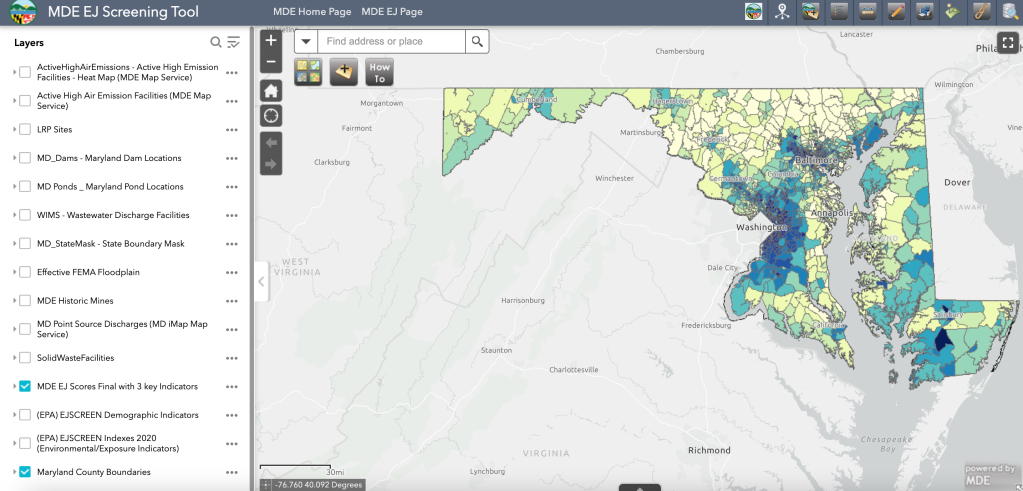Resources and Tools
by Kristen E. Humphrey, MLA, Local Assistance and Training Planner
In June 2022, the Maryland Department of the Environment (MDE) launched an online tool (utilizing geographic information system (GIS) mapping software) to help users identify potential locations of environmental contamination, environmental justice (EJ) issues and/or environmentally overburdened communities.
According to MDE’s website, the EJ Screening Tool is, “…intended to enhance agency compliance, oversight, and monitoring activities, and to enhance communication and outreach in significant permitting activities in EJ or overburdened or underserved communities.”[1]
MDE applies three socioeconomic indicators at a census tract level to screen for environmental justice concerns:
- Minority population of 50% or more (census tracts with a higher percentage of minority residents are scored higher)
- Poverty rate of 25% or more (census tracts with a higher percentage of low-income residents are scored higher)
- English proficiency: more than 15% of population as having limited English proficiency (census tracts with a higher percentage of limited English proficient residents are scored higher)[2]
What is Environmental Justice?
The US EPA defines environmental justice as, “the fair treatment and meaningful involvement of all people regardless of race, color, national origin, or income, with respect to the development, implementation, and enforcement of environmental laws, regulations, and policies.”
The EPA further states that “this goal will be achieved when everyone enjoys: the same degree of protection from environmental and health hazards; and equal access to the decision-making process to have a healthy environment in which to live, learn, and work.”
Despite gaining more traction and recognition in recent years, the history of the environmental justice movement in the United States dates back to, and has close ties with, the Civil Rights Movement of the 1950s and 60s.
Inarguably one of the earliest events was the famous Memphis Sanitation Strike, an incident commanding the attention of Dr. Martin Luther King, Jr., in which sanitation workers fought for better wages and safer working conditions. (For more information on the history of environmental justice in the US, view an interactive timeline on EPA’s EJ website.)
As recently as 2021, federal government support for addressing environmental justice issues got a huge boost when President Biden signed Executive Order (EO) 14008, Tackling the Climate Crisis at Home and Abroad, creating the government-wide Justice40 Initiative.
The concept behind the Justice40 Initiative is to ensure that “40 percent of the overall benefits of federal investments flow to disadvantaged communities that are marginalized, underserved, and overburdened by pollution” in the areas of “climate, clean energy, energy efficiency, affordable and sustainable housing, training and workforce development remediation and reduction of legacy pollution and the development of critical clean water and wastewater infrastructure.” [4]
To help EJ Screen users, MDE created an Environmental Justice in Maryland story map, that demonstrates various functions of the screening tool and shows the types of data it uses. It also describes how to create screening reports, with detailed instructions to make it useful for anyone unfamiliar with GIS computer mapping. Users can select a point, community, or larger area within a census tract, choose the type of base map on which data are to be displayed, draw around specific features, or select specific geographic coordinates. A measuring tool is also available to determine distances between pollution sources and vulnerable populations, including institutions such as schools.

Displayed data can include not only contamination sources for air and water discharges, but also where facilities that handle or process pollutants are located, such as landfills, municipal solid waste facilities, dams and storage ponds, incinerators, medical waste incinerators, construction/demolition landfills, transfer stations, and transportation routes.
The screening tool enables users to better understand the nature and number of environmental stressors and potential disparities affecting Maryland communities. Additionally, it helps support MDE’s role of administering regulatory and infrastructure programs, “…to protect and restore the environment for the health and well-being of all Marylanders,” and its specific goals to “implement programs that reduce existing environmental inequities and avoid the creation of new inequities in communities that are overburdened or underserved.[4]”
To learn more about environmental justice and the Maryland Department of the Environment’s Environmental Justice Screening Tool, or to report an environmental justice issue, please visit MDE’s website, or contact Devon Dodson, Assistant Secretary, at devon.dodson@maryland.gov.
[1] https://mdewin64.mde.state.md.us/EJ/
[2] Ibid.
[3] Ibid.
[4] https://www.whitehouse.gov/environmentaljustice/justice40/

Pingback: Resources to Help Jurisdictions Meet the Planning Requirements of HB 90 (2021) | Maryland Planning Blog